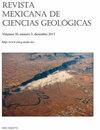金红石的U-Pb年代学:解读墨西哥南部瓦哈坎杂岩麻粒岩的冷却历史
IF 0.5
4区 地球科学
Q4 GEOSCIENCES, MULTIDISCIPLINARY
Revista Mexicana De Ciencias Geologicas
Pub Date : 2020-07-28
DOI:10.22201/cgeo.20072902e.2020.2.1557
引用次数: 3
摘要
金红石(TiO2)是一种重矿物,常见于许多岩性中,如基性火成岩、高级变质岩以及沉积碎屑岩中的碎屑。其化学成分对结晶环境敏感,可以表征变质岩中的变质基或变质沉积原岩。由于能够在其结晶网络中接受U,至少在变质沉积的高级原岩中,金红石可以通过U-Pb地质年代测定法测年。此外,U-Pb系统的闭合温度约为600°C,使金红石成为一种合适的计时器,与锆石互补,以揭示沉积硅碎屑覆盖层和基底单元中的物源和剥露路径。此外,温度计中的锆可以非常精确地计算金红石结晶温度。在这里介绍的示例案例中,重点是Grenvillian-Wahacan杂岩(OC)的麻粒岩相单元,金红石结晶发生在808–873°C范围内。不同地区的数据表明,Zapotecan麻粒岩相事件(约990 Ma)后的冷却和剥露在构成OC的不同构造切片之间是不均匀的。冷却发生在麻粒岩峰值之后的中部(诺奇克斯特兰-瓦哈卡州),快速冷却速率约为40°C/Ma。在北部和南部,冷却到约600°C的速度要慢得多,Coatepec(Puebla)北部OC露头的计算冷却速度为约3°C/Ma,Ejutla(Oaxaca)以南约6°C/Ma。这可能与多种因素的组合有关,例如造山带某些部分的早期坍塌、俯冲板块条件的变化,或者更普遍地说,与扎波特坎造山运动和亚马逊-巴尔蒂卡拼合期间地球动力学条件的突然变化有关。这个应用于属于OC的一些变质沉积岩性的例子表明,Zapotecan麻粒岩相事件(约990 Ma)后的剥露在组成OC的不同构造切片之间是不均匀的,发生在麻粒岩峰值后的中央扇区(Nochixtlán-Oaxaca),快速冷却速率约为40ºC/M.y。,而在北部和南部,冷却至约600ºC的速度要慢得多,计算出的冷却速度为约3ºC/M.y.(北部,普埃布拉州科特佩克的OC露头)至约5.5ºC/M.y.(瓦哈卡州)。这可能与多种因素的组合有关,例如造山带某些部分的早期坍塌、受试板块的条件变化,或者更普遍的是,在罗迪尼亚拼合作用的早期阶段,地球动力学条件的突然变化。这个例子清楚地说明了采用微量分析技术的优点,该技术能够解决有限的晶畴化学变化,以获得准确和精确的温度和年龄值。此外,至关重要的是,将具有不同闭合温度的几种矿物组合在一起,并收集在定义明确、公认的构造切片中,以了解它们的行为,并在地质时期构建有意义的冷却曲线,从而能够更好地表征和解释它们的构造演化。本文章由计算机程序翻译,如有差异,请以英文原文为准。
U-Pb geochronology of rutile: deciphering the cooling history of the Oaxacan Complex granulites, southern Mexico
Rutile (TiO2) is a heavy mineral, commonly found as accessory in many lithologies, such as basic igneous rocks, high-grade metamorphic units, as well as a detritus in sedimentary clastic rocks. Its chemical composition is sensitive to the crystallization environment, allowing a characterization of either metabasic or metasedimentary protoliths in metamorphic rocks. Thanks to the capability to accept U in its crystalline network, at least in metasedimentary, high-grade protoliths, rutile can be dated by U-Pb geochronology. Furthermore, its closure temperature of ca. 600 °C for the U-Pb system makes rutile a suitable chronometer, complementary to zircon, to unravel provenance and exhumation paths in both sedimentary siliciclastic cover and basement units. Besides, the Zr-in thermometer allows for a very precise calculation of the rutile crystallization temperature.
In the example case presented here, focused on granulite facies units of the Grenvillian Oaxacan Complex (OC), rutile crystallisation took place in the range 808–873 °C. Data for different localities indicate that cooling and exhumation after the Zapotecan granulite facies event (ca. 990 Ma) was heterogeneous among the different tectonic slices that constitute the OC. Cooling occurred in the central sector (Nochixtlán-Oaxaca) right after the granulite peak, with fast cooling rates of ca. 40 °C/Ma. To the north and south, the cooling to ca. 600 °C was much slower, with calculated cooling rates of ca. 3 °C/Ma for the northern OC outcrops in Coatepec (Puebla) to ca. 6 °C/Ma south of Ejutla (Oaxaca). This can be related to a combination of factors, such as an early collapse of some sectors of the orogen, a change of conditions in the subducing plate, or more in general, to a sudden change in the geodynamic conditions during the Zapotecan orogeny and Amazonia-Baltica amalgamation.
This application example to some metasedimentary lithologies belonging to the OC demonstrates how the exhumation after the Zapotecan granulite facies event (ca. 990 Ma) was heterogeneous among the different tectonic slices that compose the OC, having occurred in the central sector (Nochixtlán-Oaxaca) right after the granulite peak, with fast cooling rates of ca. 40 ºC/M.y., whereas to the North and South the cooling to ca. 600 ºC was much slower, with calculated cooling rates of ca. 3 ºC/M.y. (north, OC outcrops in Coatepec, Puebla) to ca. 5.5 ºC/M.y. south of Ejutla (Oaxaca). This can be related to a combination of factors, such as an early collapse of some sectors of the orogen, change of conditions in the subjecting plate, or more in general, to a sudden change in the geodynamic conditions during the early stages of the Rodinia amalgamation.
This example sharply illustrates the advantage of employing microanalytical techniques, able to resolve restricted crystal-domain chemical variations, to obtain accurate and precise temperature and age values. Furthermore, it is paramount to combine several mineral species with different closure temperatures, and collected in well-defined, recognized tectonic slices, to understand their behavior and construct meaningful cooling curves through geologic time, capable to better characterize and interpret their tectonic evolution.
求助全文
通过发布文献求助,成功后即可免费获取论文全文。
去求助
来源期刊

Revista Mexicana De Ciencias Geologicas
地学-地球科学综合
CiteScore
1.00
自引率
12.50%
发文量
0
审稿时长
6-12 weeks
期刊介绍:
Revista Mexicana de Ciencias Geológicas (RMCG) publishes original research papers on geological processes of broad interest, and particularly those dealing with regions of Latin America. The RMCG also publishes review papers on topics of current interest, and on the geology and tectonics of geological provinces of Latin America. Besides, it offers the opportunity for host editors to publish special thematic issues.
 求助内容:
求助内容: 应助结果提醒方式:
应助结果提醒方式:


